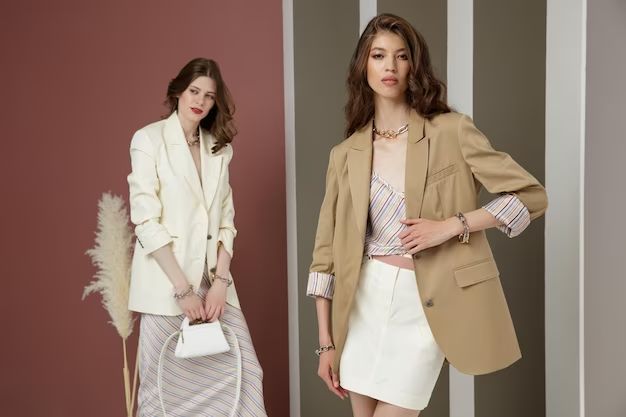Beige and cream are two popular neutral colors often used in fashion and clothing. While they may appear similar at first glance, there are some key differences between these shades that are good to know when shopping for apparel and putting together outfits.
Defining Beige and Cream
Beige is a pale brown color that can range from a yellowish tan to a light grayish brown. It sits between the color white and the color brown on the color spectrum. Beige gets its name from French, where the word originally meant natural wool that has been neither bleached nor dyed. Today, the term beige refers to a neutral off-white color that can have warm yellow, cool gray, or subtle pink undertones. Light beige is often used to describe a very pale, almost white shade of beige.
Cream is an off-white color that is paler than beige but richer than white. It has a warm, pale yellow base and can be associated with colors like cream, eggshell, ivory, and buttermilk. Cream sits closer to white on the color wheel than beige, but still has a subtle warm tone that distinguishes it from stark white. It often has a pastel yellow tone. Cream can range from an off-white with very subtle warmth to a pale yellow.
Comparing Color Values
Looking at the hexadecimal color values helps illustrate the visual differences between beige and cream:
| Color | Hex Value |
|---|---|
| Beige | #F5F5DC |
| Light Beige | #F5F5DC |
| Cream | #FFFFF0 |
As you can see, beige has more of a yellow-brown base while cream is closer to white. Cream has higher values of red, green, and blue light mixed in compared to beige. Beige appears more brown and muted while cream has a brighter, more saturated pale yellow appearance.
Beige vs. Cream in Fashion
In the fashion world, beige and cream occupy slightly different roles:
- Beige is considered more casual and earthy, with its muted brownish-gray tone. It’s commonly used in athleisure wear, casual daywear, and bohemian or rustic styles.
- Cream reads as more polished, elegant, and formal than beige, while still remaining neutral. It’s popular for cocktail dresses, cashmere sweaters, negligees, and formal trousers.
Cream clothing flatters warm complexions with yellow undertones. Beige clothing pairs well with cool skin tones thanks to its subtle gray tone. Both beige and cream work as neutral basics that can be easily dressed up or down.
Some examples of beige and cream clothing:
- Beige clothing: Trench coats, cargo pants, chunky sweaters, t-shirts, hiking pants, raw denim
- Cream clothing: Silk camisoles, cashmere turtlenecks, pleated trousers, lace dresses, cardigans, blazers
Beige and Cream Color Palettes
Beige and cream palettes create different moods. Beige palettes feel earthy, subtle, and relaxed. Cream palettes feel airy, delicate, and romantic. Here are some colors that complement each shade:
Beige color palettes:
- Rich wood tones like walnut, oak, mahogany
- Warm neutrals like tan, almond, sand
- Natural greens like olive, sage, moss
- Earth tones like terracotta, ochre, rust
- Blues and grays like denim, steel, charcoal
Cream color palettes:
- Soft pastels like blush, lavender, butter
- Jewel tones like ruby, emerald, sapphire
- Metallics like rose gold, champagne, silver
- Black and white for contrast
- Pink, peach, coral
When using beige and cream together, cream plays the role of the brighter accent shade against the more subdued beige backdrop. The lighter cream helps make the beige pop.
Beige vs. Cream Home Decor
The warm, welcoming qualities of beige and cream make them ideal neutral backdrops for home decor. Here’s how they differ:
- Beige works well in rustic, farmhouse, industrial, or bohemian rooms thanks to its earthy vibe.
- Cream suits airy cottages, vintage inspired spaces, and shabby chic decor with its dreamy, ethereal look.
Both beige and cream make great wall colors. Beige feels relaxing and casual, while cream makes a space feel softly elegant. Use beige on larger surfaces and cream for accents and decorative details.
Some ways to use beige and cream:
- Sofas, chairs, pillows, poufs
- Paint colors for walls, trims and cabinets
- Lampshades, curtains, rug accents
- Table linens, blankets, throws
- Kitchenware like canisters and dish towels
Beige vs. Cream Makeup
In cosmetics, beige and cream refer to shades used for face makeup. Knowing the difference helps you find the right tone match:
- Beige makeup has yellow/olive undertones that match well with medium to tan complexions. Beige foundation and powders help warm up fair skin.
- Cream makeup has peachy/pink tones that suit very fair to light skin. Cream foundation and concealers provide brightening highlights.
Examples of beige and cream makeup products:
- Beige face makeup: Foundation, bronzer, blush, contour powder
- Cream face makeup: Concealer, tinted moisturizer, highlighter, setting powder
Test shades on your jawline to see if the undertones match your skin’s natural tone. Beige and cream can be mixed together to customize the perfect neutral base.
Conclusion
While beige and cream may seem similar when viewed separately, side by side their differences become more apparent. Beige is a muted, earthy neutral with subtle cool gray and warm brown tones. Cream is a brighter, more vivid shade with distinct pastel yellow tones. Beige suits more casual everyday styles. Cream has an elegant, feminine aesthetic. Both serve as timeless, versatile neutrals that work for clothing, decor, and makeup.

